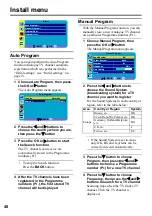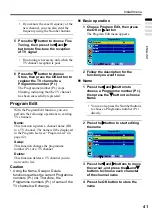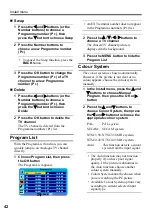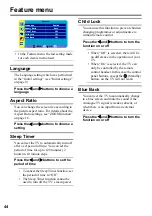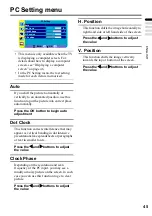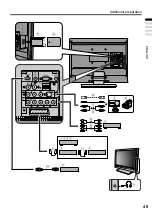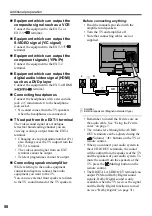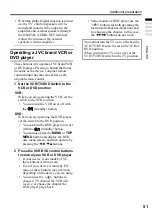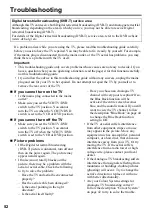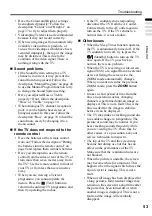
Troubleshooting
53
ENGLISH
• Have the Colour and Bright-1 settings
been adjusted properly? Follow the
description “Colour” and “Bright-1” on
page 37 to try to adjust them properly.
• Videotaping Teletext is not recommended
because it may not record correctly.
• When viewing images from commercially
available video software products, or
videos from videotapes which have been
recorded improperly, the top of the image
may be distorted. This is due to the
condition of the video signal. There is
nothing wrong with the TV.
Sound problems
• If the Sound System setting for a TV
channel is incorrect, it may prevent the
sound from being issued. Follow the
description “Manual Program” on page 40
to use the Manual Program function to try
to change the Sound System setting.
• Have you adjusted Bass or Treble
properly? If not, follow the description
“Bass” or “Treble” on page 39.
• When Analogue TV channel reception is
poor, it can be hard to hear stereo or
bilingual sound. In this case, follow the
description “Bass” on page 39 to hear the
sound more easily by changing it to a
mono sound.
If the TV does not respond to the
remote control
• Have the batteries of the remote control
worn out? Follow the description “Putting
the batteries into the remote control” on
page 9 and replace them with new batteries.
• Have you attempted to use the remote
control from the sides or rear of the TV or
from more than seven metres away from
the TV? Use the remote control in front of
your TV or from less than seven metres
away.
• When you are viewing a Teletext
programme, you cannot operate the
menus. Press the
(Text) button to
return to the ordinary TV programme, and
then try operating the menus.
• If the TV suddenly stops responding,
disconnect the TV from the AC outlet.
Connect them to the AC outlet again to
turn on the TV. If the TV returns to a
normal state, it is not a failure.
Other issues
• When the Sleep Timer function operates,
the TV is automatically turned off. If the
TV suddenly turns off, try to press the
(Standby) button to turn on the TV
once again. If the TV goes back to
normal, there is no problem.
• When the TV is receiving a wide-screen
signal (WSS) or a signal from an external
device affecting the screen size, the
ZOOM mode automatically changes.
When you want to resume the previous
ZOOM mode, press the
ZOOM
button
again.
• It takes a short period of time from the
time an operation such as changing
channels is performed until an image is
displayed. This is not a fault. This is the
time needed for the image to stabilise
before it can be displayed.
• The TV may make a crackling sound due
to a sudden change in temperature. The
picture or sound may be normal. If you
hear crackling sounds frequently while
you are viewing the TV, there may be
other causes. As a precaution, ask your
service technician to inspect it.
• The top of the TV and the screen may
become hot during use but this has no
affect on the performance of the TV.
Make sure that the ventilation holes are
not blocked.
• When the picture is unstable, the screen
may become white for a moment. This
happens when the signal which drives the
liquid crystal is missing. This is not a
fault.
• When a still image has been displayed for
a long period, a faint residual image may
remain on the screen for a short time after
the power has been turned off or when
another image is displayed. This is not a
fault and the image will eventually
disappear.
Содержание LT-19DK8WG
Страница 50: ...Additional preparation 49 ENGLISH ...
Страница 56: ...P N 4J 0AE01 011 1007TKH BQ BQ ...


